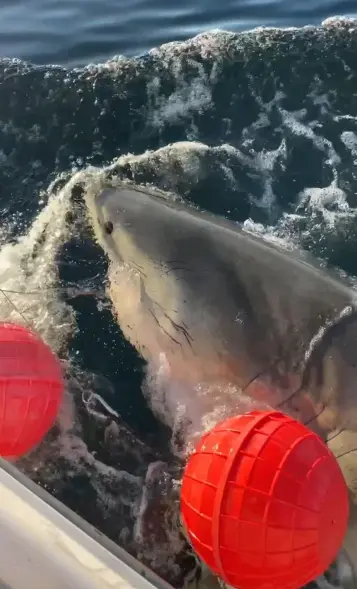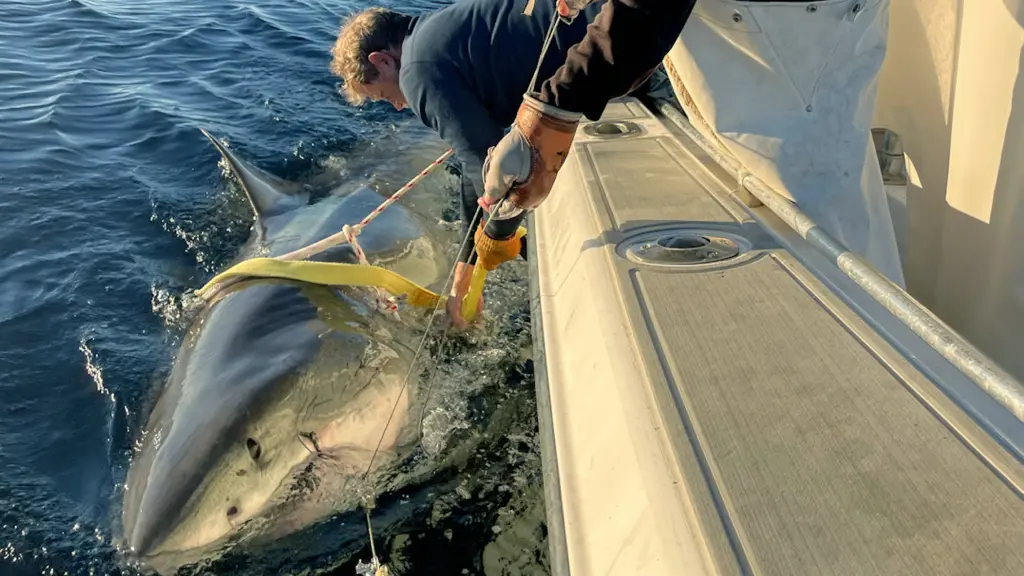Meet “Contender,” the largest male great white shark ever recorded in the Atlantic — a 13-foot, 1,653-pound predator now pinged off the New Jersey coast
A giant of the deep has returned to the spotlight. The largest male great white shark ever recorded in the Atlantic Ocean — a 13-foot, 1,653-pound behemoth named Contender — has been pinged off the coast of New Jersey, thrilling marine scientists and shark enthusiasts around the world. Tagged by the nonprofit OCEARCH earlier this year, Contender has become a living legend of the Atlantic, a reminder that even in an era of satellites and science, the ocean still hides giants.

Contender was first tagged in January 2025 near the border between Florida and Georgia, when researchers aboard the OCEARCH vessel fitted him with a satellite tracker. At roughly 32 years old, Contender represents a rare glimpse into the life of a mature male great white shark — a demographic scientists still know remarkably little about. His sheer size stunned the OCEARCH team: weighing more than three-quarters of a ton and stretching nearly the length of a small car, Contender dwarfs most males typically observed in the region.
Since then, the shark’s journey has been nothing short of epic. After spending much of the winter cruising off the Carolinas, he began a slow but steady migration up the Eastern Seaboard. By late spring, he was detected off the coast of Virginia and later Massachusetts, where cooler waters and abundant seal populations offer an ideal hunting ground. Then, in early November, OCEARCH’s global tracking system lit up once again: Contender had resurfaced off the coast of Atlantic City, New Jersey. The sighting was confirmed at 10:19 p.m. on November 11 — his first ping in several weeks and a clear sign that the massive predator was heading south once again.

For researchers, Contender’s movement is more than a spectacle. It’s an invaluable piece of scientific data that helps fill critical gaps in our understanding of great white shark behavior. “He’s rewriting what we thought we knew about male great whites in the Atlantic,” an OCEARCH marine biologist said in a recent update. “Every ping from Contender teaches us something new about their seasonal movements, feeding habits, and even how climate change may be altering their migration routes.”
Great white sharks have long captured human imagination — symbols of both awe and fear — but real-world research shows a more complex truth. These apex predators play a vital role in maintaining ocean balance by regulating prey populations, especially seals and large fish. Without sharks, ecosystems begin to collapse, triggering a ripple effect that affects everything from coral reefs to fisheries. Tracking individuals like Contender gives scientists a window into how these top predators sustain the ocean’s delicate equilibrium.
What makes Contender’s tracking so significant is that mature male great whites are notoriously difficult to study. Most tagging efforts historically focus on females, which tend to migrate closer to shore for breeding purposes. Males, on the other hand, spend much of their lives in deeper, colder waters, far from human observation. The fact that Contender routinely swims close enough to be tracked along the U.S. East Coast is an extraordinary opportunity for researchers to analyze his routes and behavior.

OCEARCH’s interactive Global Shark Tracker has become a viral sensation, allowing the public to follow Contender’s path in real time. The data show that since January, he has traveled more than 2,500 miles, covering waters from Georgia to Nova Scotia and back again. Each time his dorsal fin breaks the surface and pings a satellite, his journey adds another line to an evolving map of shark migration — a map that’s helping redefine what we know about these magnificent animals.
But beyond the scientific fascination, Contender’s story has captured hearts and imaginations. Photos shared by OCEARCH show the sheer scale of the creature — his gray back glinting beneath the sun, massive jaws partially open as he glides through the deep blue. “You can feel his power even from the deck,” one researcher said. “It’s humbling. You realize how small we really are out there.”
Despite his size, Contender is not a threat to people. Marine experts emphasize that great whites are not the mindless killers of popular myth. They rarely interact with humans and spend most of their lives far offshore, preying on seals, tuna, and other marine animals. The fact that Contender was detected near New Jersey doesn’t signal danger — rather, it highlights how close our human world lies to the ocean’s wild frontier.
Still, the thought of a 1,600-pound shark cruising beneath the waves off the East Coast is enough to inspire both fear and fascination. The last time OCEARCH recorded a male great white of comparable size was a decade ago, and that shark was nearly 200 pounds smaller. Contender’s record-breaking measurements set a new benchmark for Atlantic shark research and underscore the importance of ongoing marine conservation.
Scientists hope that continued monitoring will reveal where Contender goes next. If his patterns align with previous migrations, he may travel back toward the warmer waters of the southeastern U.S. or even the Gulf of Mexico over the winter months. These long-distance movements are key to understanding how sharks adapt to changing ocean conditions — especially as warming waters shift prey availability and alter traditional migration corridors.
Contender’s tracking also helps shine a light on broader conservation challenges. Great whites are classified as “vulnerable” by the International Union for Conservation of Nature (IUCN), primarily due to overfishing, habitat loss, and the slow reproduction rates of the species. Each adult shark is precious to maintaining population stability, and long-term tagging projects like OCEARCH’s are critical to protecting them. By studying Contender, scientists can better identify breeding areas, migratory routes, and environmental threats that need immediate protection.
For OCEARCH founder Chris Fischer, who has led dozens of shark-tagging expeditions around the world, Contender’s journey represents hope — proof that sustained research and public education can change how society views these animals. “We used to fear them,” Fischer said in an earlier interview, “but now we’re learning to respect them. Sharks like Contender are ocean guardians. When they thrive, the ocean thrives.”
That message resonates strongly as Contender glides silently through the dark Atlantic, a symbol of survival and mystery. Each ping from his satellite tag cuts through the noise of human life, reminding us that nature’s rhythm still pulses far beyond the shoreline. He is part myth, part science — an ancient wanderer still charting paths we’ve only begun to understand.
As his journey continues, Contender’s presence off New Jersey offers more than just a scientific milestone. It’s a powerful story of endurance, evolution, and coexistence — a reminder that the ocean is alive with giants and that humanity’s role, for once, is simply to listen and learn. Somewhere in the depths tonight, a 13-foot shark swims on, his tracker silently blinking beneath the waves, carrying with it both our curiosity and our hope.



